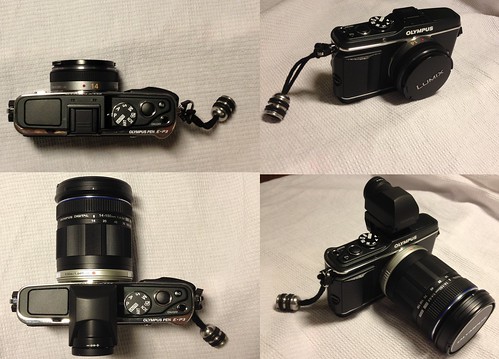My Olympus Pen experiment
I recently gave up a proper dSLR (digital SLR - one of those big cameras where lenses change) for something that promised to be smaller but not compromise much in photographic experience - the Olympus Pen EP3. It is a micro4/3 camera, i.e. its sensor is almost as big as dSLRs leading to comparable image quality, but slightly smaller so that the whole camera and lenses can be much smaller. It is supposed to combine the advantages of point and shoot cameras (small size) with those of dSLRs (lens choices, higher quality pictures, add- ons, etc). See [more](http://www.dpreview.com/articles/0344780582 /mirrorless-cameras-a-primer) on the class of camera the Olympus EP3 represents.
After 3 months of getting to know the new system, it is a good time to write about it. My aim is to distill the information that ended up mattering the most to me and write the post that I would have liked to have read before making the decision to switch.
Overall, it is a compromise in terms of image quality and portability. This I knew beforehand. The quality is still very good and usually I prefer the balance between portability and quality that the small camera give. One unexpected outcome has been that for many things the micro4/3 camera is better.
The main advantages have been
Portability - With a small lens, I can carry the micro4/3 camera with me anywhere. And that has definitely helped take more photos, and take photos without planning.

Lack of intimidation of subjects - The micro4/3 camera looks like something people are used to, so they are more relaxed around it, which often allows for better photos. Many people are impressed by the retro look, which can be a distraction but also an ice-breaker.
Screen instead of viewfinder - The lack of a viewfinder is a serious disadvantage in cases where manual focus is required, long zooming (it helps counter camera shake) and bright outdoors situations. In other cases the ability to focus fast using the screen is an advantage over dSLRs, as it allows shooting from strange angles and can be discreet which helps with people photos or photos in public places. The EP3 'touch to shoot' mode is great for focusing without dealing with focus areas (just touch the screen!). Overall usually I am happy without a viewfinder, then again I live in Scotland where a surplus of light tends not to be a problem. When I need a viewfinder it is indispensable and I had to buy one that clips on, which is an annoying inconvenience.

User friendliness for handing the camera to others - It is really important to trust you will get good photos from random people using the camera. This is the case more often with a micro4/3 camera compared to a dSLR. Face detection auto focus is part of this user friendliness and I end up using it all the time myself.
Video - There is autofocus, in contrast to my previous dSLR (Nikon D90, although newer bodies are catching up). It can be silent, depending on lens, which is great. Sound is recorded in stereo, also great! The in-camera stabilisation of the EP3 makes the video look unnatural and is best to turn off.
Nice touches
Usually I don't think about them, but would probably miss them:
In-camera stabilisation - Coupled with a prime lens it means reliable handheld shooting in available light.
Lens distortion correction - Apparently happens automatically in jpegs.
Camera effects - I don't use them often, but when I do they are nice.

Main problems have been
Motion tracking and action shooting - In short, there is a high miss rate in animal and people action shots. A workaround is to manually focus (easy to set up to the touch of a button) and shoot with pre-adjusted focus, but it is a worse shooting experience than a dSLR where action is handled effortlessly by the camera. In practice there are not many occasions I need such fast focus, but when I do it is frustrating.
Physics - Equally large lens apertures result in a broader depth of field on the micro4/3 system compared to dSLRs, especially full frame ones. This will never change and means that prime lenses will always look better with dSLRs, in terms of the intensity of the out of focus part of a picture. This can be a problem. Currently the best solution is the Olympus 45 mm lens which is quite nice for portraits, and has the benefit that it does not intimidate people. For macro work it is usually an advantage to have a broad depth of field at large apertures.

Problems that don't matter
High ISO noise (grain) - It is higher and noticeable in dark photos, even by non-photographers. However in the grand scheme of things it is counteracted by the use of prime lenses, the very usable ISO 800 and partially by the in-camera stabilisation. Also noise is subjective, was much worse in the pre-digital era and can sometimes be considered beautiful (although not my cup of tea). So overall I dismiss it as something people learn to focus on, while in the grand scheme of things has little to do with picture quality.
Battery life - It is much shorter than a dSLR (which typically goes on for days). Also the micro4/3 camera must be turned on and off constantly to conserve battery, unlike dSLRs which do not use battery when on. In practice the micro4/3 startup time is faster than storing the lens cap, I bought a second cheap battery and so far I can do a day of shooting without depleting two batteries. So I worry about battery life much less than I thought I would.
Finding a bag - I spent a lot of time trying to find the perfect bag until I decided it is an advantage that the camera size varies so much depending on the lens and add-ons it has. Currently I have a dSLR lens pouch to carry the camera with a prime lens and a bigger bag in case I use a bigger lens and want to carry backup lenses. All accessories and lenses are small compared to dSLR equivalents, that it seems practical to split them in various pockets and forget about the bag, which is an advantage over dSLRs.

Default settings - At the default settings of the Olympus EP3 the noise reduction applied is too strong to most people's liking and skin tones and hair look like watercolours. It is not a big deal as none of this happens with noise reduction off, but I did have to experiment for a while. Also it is mostly noticeable in people photos, when I take nature photos the overall result is usually pleasing. I read that Panasonic cameras deal better with noise by default and I am confident that technological advancement will improve this in time.
Lack of saved presets - I really liked the ability to recall different settings on my Nikon D90 with the touch of a button (I usually use one for portrait and one for saturated-nature). It takes slightly more steps on the Olympus EP3, but the smart menu where most-commonly used functions are on one screen, and the easy white balance setting, compensate so it is not a big deal. More generally, there are enough buttons to change settings without going through menus, and the smart menu gives fast access to most commonly used settings that I don't find it slower to work with than a dSLR.
Lens prices - Generally lenses are more expensive than equivalent dSLR lenses, especially since there is no used market. If they turn out not lose their value, as dSLR lenses don't, their high price should not be a big problem as they can be sold for little loss. The uncertainty of the new market they are competing at leaves value as an open question at the moment. However I am hopeful that I can recover most of the cost of lenses by selling on eBay, as I did with my Nikon gear.
Summary
If it comes down to value for money, it is difficult to judge because it depends on usage and priorities. The fact that micro4/3 are as expensive as mid-level dSLRs (although they keep getting cheaper) without the photographic quality or professional abilities (like high frame rates, motion tracking, usable high ISO and extreme bokeh) makes them seem expensive.
Micro4/3 are still a niche market, and their potential audience is not as focused as the dSLR audience meaning there is probably more variation within micro4/3 cameras than within dSLRs. They are also not established, for example Sony is making its own equivalents, with larger sensors (and lenses) and Nikon is trying too. Currently the micro4/3 system is more mature as a whole, for example there are more lens choices than Sony will be able to produce in the coming years, although it will eventually catch up. However Sony cameras have impressive abilities currently lacking in micro4/3 cameras, like better image quality, in-camera panorama modes, real HDR and the like, so they may end up dominating. So there is some risk in investing in the micro4/3 system.
I would still have doubts in the use of micro4/3 on an important event such as my wedding, because some essential shots might be missed even if most would be ok.
However most of the time I am shooting for fun, and I have lots of fun with the EP3. I also like that it feels like a camera and not an electronic gadget, which is not the direction all 'micro4/3 niche' cameras take. Sometimes the compromise in quality is evident to non-specialists, other times the ability to have fun with the camera more than compensates when it is captured in the photos.
